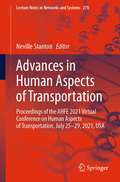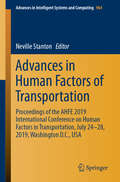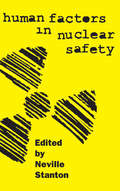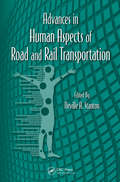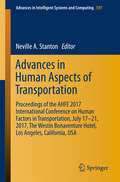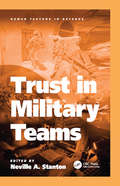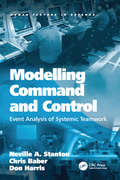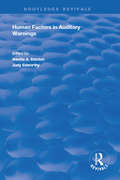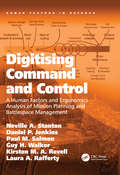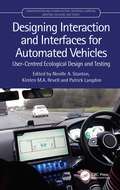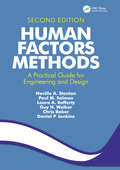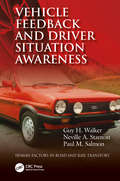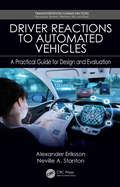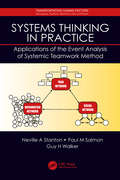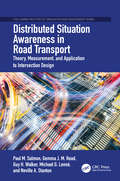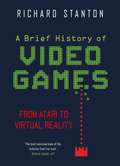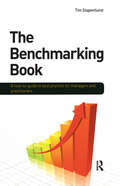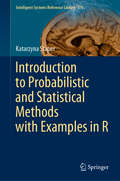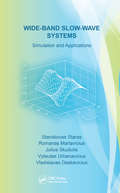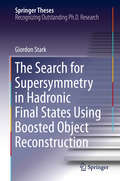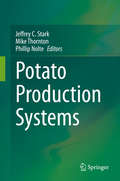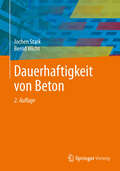- Table View
- List View
Advances in Human Aspects of Transportation: Proceedings Of The Ahfe 2020 Virtual Conference On Human Aspects Of Transportation, July 16-20, 2020, Usa (Advances In Intelligent Systems And Computing Ser. #1212)
by Neville StantonThis book discusses the latest advances in the research and development, design, operation, and analysis of transportation systems, including road, rail, aviation, aerospace and maritime as well as their supporting systems and infrastructure. Focusing specifically on the contributions made by human factors and ergonomics, it analyses a wealth of topics, methods and technologies associated to accident analysis, automated and autonomous vehicles, assessment of comfort and distraction of drivers, and environmental concerns, giving emphasis to intelligent transport systems and driver-assistance systems, among other topics. Based on contributions to the AHFE 2021 Conference on Human Aspects of Transportation, held virtually on July 25-29, 2021, from USA, this book offers extensive information on the latest human factors and ergonomics thinking and practice in the area of transportation, and a thought-provoking guide to researchers, graduate students and professionals in this field.
Advances in Human Factors of Transportation: Proceedings of the AHFE 2019 International Conference on Human Factors in Transportation, July 24-28, 2019, Washington D.C., USA (Advances in Intelligent Systems and Computing #964)
by Neville StantonThis book discusses the latest advances in research and development, design, operation and analysis of transportation systems and their complementary infrastructures. It reports on both theories and case studies on road and rail, aviation and maritime transportation. Further, it covers a wealth of topics, from accident analysis, vehicle intelligent control, and human-error and safety issues to next-generation transportation systems, model-based design methods, simulation and training techniques, and many more. A special emphasis is placed on smart technologies and automation in transport, and on the user-centered, ergonomic and sustainable design of transport systems. The book, which is based on the AHFE 2019 International Conference on Human Factors in Transportation, held on July 24-28, 2019, in Washington D.C., USA, mainly addresses the needs of transportation system designers, industrial designers, human–computer interaction researchers, civil and control engineers, as well as vehicle system engineers. Moreover, it represents a timely source of information for transportation policy-makers and social scientists whose work involves traffic safety, management, and sustainability issues in transport.
Human Factors in Nuclear Safety
by Neville StantonThere is a growing recognition amongst those involved with the creation and distribution of nuclear power of the value and positive impact of ergonomics, recognition heightened by the realization that safety incidents are rarely the result of purely technical failure. This work provides insights into plant design, performance shaping factors,
Advances in Human Aspects of Road and Rail Transportation (Advances in Human Factors and Ergonomics Series #14)
by Neville A. StantonHuman factors and ergonomics have made considerable contributions to the research, design, development, operation and analysis of transportation systems and their complementary infrastructure. This volume focuses on the causations of road accidents, the function and design of roads and signs, the design of automobiles, and the training of the driver. It covers accident analyses, air traffic control, control rooms, intelligent transportation systems, and new systems and technologies.
Advances in Human Aspects of Transportation: Proceedings of the AHFE 2017 International Conference on Human Factors in Transportation, July 17−21, 2017, The Westin Bonaventure Hotel, Los Angeles, California, USA (Advances in Intelligent Systems and Computing #597)
by Neville A StantonThis book discusses the latest advances in research and development, design, operation and analysis of transportation systems and their complementary infrastructures. It reports on both theories and case studies on road and rail, aviation and maritime transportation. The book covers a wealth of topics, from accident analysis, vehicle intelligent control, and human-error and safety issues to next-generation transportation systems, model-based design methods, simulation and training techniques, and many more. A special emphasis is given to smart technologies and automation in transport, as well as to user-centered, ergonomic and sustainable design of transport systems. The book, which is based on the AHFE 2016 International Conference on Human Factors in Transportation, held on July 27-31, 2016, in Walt Disney World#65533;, Florida, USA, mainly addresses transportation system designers, industrial designers, human-computer interaction researchers, civil and control engineers, as well as vehicle system engineers. Moreover, it represents a timely source of information for transportation policy-makers and social scientists dealing with traffic safety, management, and sustainability issues in transport.
Trust in Military Teams (Human Factors in Defence)
by Neville A. StantonThe objective of this book is to report on contemporary trends in the defence research community on trust in teams, including inter- and intra-team trust, multi-agency trust and coalition trust. The book also considers trust in information and automation, taking a systems view of humans as agents in a multi-agent, socio-technical, community. The different types of trust are usually found to share many of the same emotive, behavioural, cognitive and social constructs, but differ in the degree of importance associated with each of them. Trust in Military Teams is written by defence scientists from the USA, Canada, Australia and the UK, under the auspices of The Transfer Cooperation Programme. It is representative of the latest thinking on trust in teams, and is written for defence researchers, postgraduate students, academics and practitioners in the human factors community.
Modelling Command and Control: Event Analysis of Systemic Teamwork (Human Factors in Defence)
by Neville A. Stanton Chris BaberSince its inception, just after the Second World War, Human Factors research has paid special attention to the issues surrounding human control of systems. Command and control environments continue to represent a challenging domain for human factors research. Modelling Command and Control takes a broad view of command and control research, to include C2 (command and control), C3 (command, control and communication), and C4 (command, control, communication and computers) as well as human supervisory control paradigms. The book presents case studies in diverse military applications (for example, land, sea and air) of command and control. The book explores the differences and similarities in the land, sea and air domains; the theoretical and methodological developments, approaches to system and interface design, and the workload and situation awareness issues involved. It places the role of humans as central and distinct from other aspects of the system. Using extensive case study material, Modelling Command and Control demonstrates how the social and technical domains interact, and why each require equal treatment and importance in the future.
Human Factors in Auditory Warnings (Routledge Revivals)
by Neville A. Stanton Judy EdworthyFirst published in 1999, this book provides answers to many of the problems associated with the design and application of auditory warnings. It represents the position of contemporary auditory warnings research and development in a single unique volume. Application domains include air traffic control, aviation, emergency services, manufacturing, medicine, military and nuclear power. The contributors constitute many key experts in this area, some of whom are psychoacousticians, some psychologists and some ergonomists. Correspondingly, the chapters range from those covering basic topics such as audibility and localization of warnings, through psychological issues concerned with the relationship between design, understanding and the behavioural response, to the more general ergonomic issues of implementing the warnings in a particular context. Although each of the chapters takes a slightly different perspective, they all balance theoretical underpinning with practical application. The editors have undertaken to draw all of the contributions together by providing an overview of warnings research at the beginning of the book and summary of the contributions at the end. This book will appeal to all involved in the research, development, design and implementation of auditory warnings.
Digitising Command and Control: A Human Factors and Ergonomics Analysis of Mission Planning and Battlespace Management (Human Factors in Defence)
by Neville A. Stanton Daniel P. Jenkins Paul M. Salmon Guy H. Walker Kirsten M. Revell Laura A. RaffertyThis book presents a human factors and ergonomics evaluation of a digital Mission Planning and Battle-space Management (MP/BM) system. An emphasis was placed on the activities at the Brigade (Bde) and the Battle Group (BG) headquarters (HQ) levels. The analysts distributed their time evenly between these two locations. The human factors team from Brunel University, as part of the HFI DTC, undertook a multi-faceted approach to the investigation, including: - observation of people using the traditional analogue MP/BM processes in the course of their work - cognitive work analysis of the digital MP/BM system - analysis of the tasks and goal structure required by the digital MP/BM - assessment against a usability questionnaire - analysis of the distributed situation awareness - an environmental survey. The book concludes with a summary of the research project's findings and offers many valuable insights. For example, the recommendations for short-term improvements in the current generation of digital MP/BM system address general design improvements, user-interface design improvements, hardware improvements, infrastructure improvements and support improvements. In looking forward to the next generation digital MP/BM systems, general human factors design principles are presented and human factors issues in digitising mission planning are considered.
Designing Interaction and Interfaces for Automated Vehicles: User-Centred Ecological Design and Testing (Transportation Human Factors)
by Neville A. Stanton Kirsten M. A. Revell Patrick LangdonDriving automation and autonomy are already upon us and the problems that were predicted twenty years ago are beginning to appear. These problems include shortfalls in expected benefits, equipment unreliability, driver skill fade, and error-inducing equipment designs. Designing Interaction and Interfaces for Automated Vehicles: User-Centred Ecological Design and Testing investigates the difficult problem of how to interface drivers with automated vehicles by offering an inclusive, human-centred design process that focusses on human variability and capability in interaction with interfaces. This book introduces a novel method that combines both systems thinking and inclusive user-centred design. It models driver interaction, provides design specifications, concept designs, and the results of studies in simulators on the test track, and in road going vehicles. This book is for designers of systems interfaces, interactions, UX, Human Factors and Ergonomics researchers and practitioners involved with systems engineering and automotive academics._ "In this book, Prof Stanton and colleagues show how Human Factors methods can be applied to the tricky problem of interfacing human drivers with vehicle automation. They have developed an approach to designing the human-automation interaction for the handovers between the driver and the vehicle. This approach has been tested in driving simulators and, most interestingly, in real vehicles on British motorways. The approach, called User-Centred Ecological Interface Design, has been validated against driver behaviour and used to support their ongoing work on vehicle automation. I highly recommend this book for anyone interested, or involved, in designing human-automation interaction in vehicles and beyond." Professor Michael A. Regan, University of NSW Sydney, AUSTRALIA
Human Factors Methods: A Practical Guide for Engineering and Design
by Neville A. Stanton Paul M. Salmon Laura A. Rafferty Guy H. Walker Chris Baber Daniel P. JenkinsThis second edition of Human Factors Methods: A Practical Guide for Engineering and Design now presents 107 design and evaluation methods as well as numerous refinements to those that featured in the original. The book has been carefully designed to act as an ergonomics methods manual, aiding both students and practitioners. The eleven sections represent the different categories of ergonomics methods and techniques that can be used in the evaluation and design process. Offering a 'how-to' text on a substantial range of ergonomics methods that can be used in the design and evaluation of products and systems, it is a comprehensive point of reference for all these methods. An overview of the methods is presented in chapter one, with a methods matrix showing which can be used in conjunction. The following chapters detail the methods showing how to apply them in practice. Flowcharts, procedures and examples cover the requirements of a diverse audience and varied applications of the methods. The final chapter, a new addition, illustrates the EAST method, which integrates several well-known methods into a teamwork analysis approach.
Vehicle Feedback and Driver Situation Awareness (Human Factors in Road and Rail Transport)
by Neville A. Stanton Guy H. Walker Paul M. SalmonA potentially troubling aspect of modern vehicle design – some would argue - is a trend for isolating the driver and reducing vehicle feedback, usually in the name of comfort and refinement but increasingly because of automation. There is little doubt cars have become more civilised over the years, yet despite this, the consequences of driver behaviour remain to a large extent anecdotal. Readers will have heard such anecdotes for themselves. They usually take the form of drivers of a certain age recalling their first cars from the 1970s or 80s, in which "doing 70 mph really felt like it". The question is whether such anecdotes actually reflect a bigger, more significant issue that could be better understood. Related questions have been explored in other domains such as aviation, where the change to ‘fly-by-wire’ did indeed bring about some occasionally serious performance issues that were not anticipated. Despite some clear parallels, automotive systems have been left relatively unstudied. The research described in this book aims to explore precisely these issues from a Human Factors perspective. This means connecting the topics of vehicle feel, vehicle dynamics, and automotive engineering with the latest research on driver situation awareness. The problem is explored experimentally from a variety of theoretical viewpoints but the outcomes are consistently practical. Here we have a promising new avenue along which the driver experience can be enhanced in novel and insightful ways. Tools and templates are provided so that engineers and designers can try different ways to boost vehicle safety, efficiency and enjoyment from a human-centered perspective. Association of American Publishers (AAP) Finalist for the 2019 PROSE Award Features Diagnosis of how vehicle feel impacts driver situation awareness, and how this could aid future vehicle designs Multi-theory approach to driver situation awareness, and how different views of this important concept give rise to different insights Comprehensive analysis of situation awareness in driving, the information requirements of drivers, and how these needs can be supported Practical descriptions of how state-of-science Human Factors methods have been applied in practice
Driver Reactions to Automated Vehicles: A Practical Guide for Design and Evaluation (Transportation Human Factors)
by Neville Stanton Alexander ErikssonDriver Reactions to Automated Vehicles focuses on the design and evaluation of the handover to and from driver and the automobile. The authors present evidence from studies in driving simulators and on the open roads to show that handover times are much longer than anticipated by previous research. In the course of the studies, Eriksson and Stanton develop compelling evidence to support the use of driving simulators for the study of handovers. They also develop guidelines for the design of handover strategies and show how this improves driver takeover of vehicle control. Features Provides a history of automobile automation Offers a contemporary analysis of the state of automobile automation Includes novel approaches in examining driver-automation interaction Presents studies of automation in driving simulators Includes on-road studies of driver automation Covers guidelines for design of vehicle automation
Systems Thinking in Practice: Applications of the Event Analysis of Systemic Teamwork Method (Transportation Human Factors)
by Neville Stanton Guy Walker Paul SalmonThis book presents the latest developments of Systems Thinking in Practice to the analysis and design of complex sociotechnical systems. The Event Analysis of Systemic Teamwork (EAST) method is applied to micro, meso and macro systems. Written by experts in the field, this text covers a diverse range of domains, including: automation, aviation, energy grid distribution, military command and control, road and rail transportation, sports, and urban planning. Extensions to the EAST method are presented along with future directions for the approach. Illustrates a contemporary review of the status of Distributed Cognition (DCOG) Presents examples of the application of Event Analysis of Systemic Teamwork (EAST) method Presents examples of the application of Event Analysis of Systemic Teamwork (EAST) method Discusses the metrics for the examination of social, task, and information networks Provides comparison of alternative networks with implications for design of DCOG in systems
Distributed Situation Awareness in Road Transport: Theory, Measurement, and Application to Intersection Design (The Human Factors of Simulation and Assessment Series)
by Neville Stanton Guy Walker Paul Salmon Gemma Read Michael LennéHow can we design transport environments that cater to the situation awareness needs of different end-users? This book answers this question by showcasing how state-of-the-art human factors theory and methods can be used to understand how situation awareness differs across drivers, cyclists, motorcyclists, and pedestrians and creates new designs that cater to these diverse situation awareness needs. Written by experts in the field and based on a major program of work funded by the Australian Research Council, this book outlines the distributed situation awareness model and provides practical guidance on how to study situation awareness naturalistically and how to create designs that support, rather than hinder, situation awareness. The book closes by outlining outline a generic framework to support similar applications in other areas, and discusses future applications in areas such as vehicle automation, artificial intelligence, and cybersecurity. Features Challenges traditional road safety analysis, design processes and conventions Outlines a novel on-road study methodology for analyzing naturalistic interactions among drivers, cyclists, motorcyclists and pedestrians Presents a review of state-of-the-art situation awareness theory and methods Provides practical guidance on a series of human factors methods Describes a framework to support the design of transport environments Evaluates new intersection concepts that encompass features designed to prevent collisions at intersections
A Brief History Of Video Games: From Atari to Virtual Reality (Brief Histories)
by Rich Stanton'Stanton writes with terrific verve and precision . . . his understanding of the seductive pleasures of gaming takes us right to its heart.'Maria Bustillos, Times Literary Supplement'The best overview book of the industry that I've read.'Andrew Liptak, io9From the first wood-panelled Pong machines in California to the masterpieces of engineering that now sit in countless homes all over the world, A Brief History of Video Games reveals the vibrant history and culture of interactive entertainment. Above all, this is a book about the games - how the experience of playing has developed from simple, repetitive beginnings into a cornucopia of genres and styles, at once utterly immersive and socially engaging. With full-colour illustrations throughout, it shows how technological advances have transformed the first dots and dashes of bored engineers into sophisticated, responsive worlds that are endlessly captivating. As thrilling and surprising as the games it describes, this is an indispensable read for anyone serious about the business of having fun.
A Brief History Of Video Games
by Rich StantonA Brief History of Video Games describes and explains the remarkable evolution of interactive entertainment, from the demonstration of Nimrod in 1951 to full-body virtual reality in 2014. Video games are a technology-led medium and this book examines everything from the first wood-panelled Pong machines in California right up to the engineering masterpieces that now sit in countless homes, with brief stopovers for dead-ends like Philips CDi and early VR. Most importantly, it?s all about the games ? how these experiences have evolved from simple call-and-response mechanics into sophisticated, captivating worlds, responsive in just about every way to players.
The Benchmarking Book
by Tim StapenhurstWith growing demands for increased operational efficiency and process improvement in organizations of all sizes, more and more companies are turning to benchmarking as a means of setting goals and measuring performance against the products, services and practices of other organizations that are recognized as leaders. The Benchmarking Book is an indispensable guide to process improvement through benchmarking, providing managers, practitioners and consultants with all the information needed to carry out effective benchmarking studies. Covering everything from essential theory to important considerations such as project management and legal issues, The Benchmarking Book is the ideal step-by-step guide to assessing and improving your company’s processes and performance through benchmarking.
Introduction to Probabilistic and Statistical Methods with Examples in R (Intelligent Systems Reference Library #176)
by Katarzyna StaporThis book strikes a healthy balance between theory and applications, ensuring that it doesn’t offer a set of tools with no mathematical roots. It is intended as a comprehensive and largely self-contained introduction to probability and statistics for university students from various faculties, with accompanying implementations of some rudimentary statistical techniques in the language R. The content is divided into three basic parts: the first includes elements of probability theory, the second introduces readers to the basics of descriptive and inferential statistics (estimation, hypothesis testing), and the third presents the elements of correlation and linear regression analysis. Thanks to examples showing how to approach real-world problems using statistics, readers will acquire stronger analytical thinking skills, which are essential for analysts and data scientists alike.
Wide-Band Slow-Wave Systems: Simulation and Applications
by Stanislovas Staras Romanas Martavicius Julius Skudutis Vytautas Urbanavicius Vladislavas DaskeviciusThe field of electromagnetics has seen considerable advances in recent years, based on the wide applications of numerical methods for investigating electromagnetic fields, microwaves, and other devices. Wide-Band Slow-Wave Systems: Simulation and Applications presents new technical solutions and research results for the analysis, synthesis, and design of slow-wave structures for modern electronic devices with super-wide pass-bands. It makes available, for the first time in English, significant research from the past 20 years that was previously published only in Russian and Lithuanian. The authors examine electrodynamics, multiconductor lines, and numerical methods for the modeling, simulation, analysis, and design of various super-wide-band slow-wave structures, including helical, meander, and gutter-type systems. The book features: The electrodynamic method for analysis of helical structures containing periodical inhomogeneities The multiconductor line method for analysis of complex helical, meander, and gutter-type wide-band slow-wave structures The method of moments for modeling and analysis of multiconductor lines containing a limited number of lines and meander structures with limited length Use of powerful software systems Microwave Office®, MICROWAVE STUDIO®, and MATLAB® for modeling, analysis, and design A synergy of various methods for investigating and designing wide-band slow-wave structures Solution of specific problems related to the design of wide-band and super-wide-band electrodynamic delay and deflection systems Principles of computer-aided design of slow-wave structures Presenting the theory, principles, properties, and applications of wide-band and super-wide-band slow-wave structures, this book will be of interest to students, engineers, researchers, and designers in the fields of electronic and microwave engineering.
Sparse Image and Signal Processing
by Jean-Luc Starck Fionn Murtagh Jalal FadiliThis book presents the state of the art in sparse and multiscale image and signal processing, covering linear multiscale transforms, such as wavelet, ridgelet, or curvelet transforms, and non-linear multiscale transforms based on the median and mathematical morphology operators. Recent concepts of sparsity and morphological diversity are described and exploited for various problems such as denoising, inverse problem regularization, sparse signal decomposition, blind source separation, and compressed sensing. This book weds theory and practice in examining applications in areas such as astronomy, biology, physics, digital media, and forensics. A final chapter explores a paradigm shift in signal processing, showing that previous limits to information sampling and extraction can be overcome in very significant ways. Matlab and IDL code accompany these methods and applications to reproduce the experiments and illustrate the reasoning and methodology of the research are available for download at the associated web site.
Sparse Image and Signal Processing: Wavelets, Curvelets, Morphological Diversity
by Jean-Luc Starck Fionn Murtagh Jalal M. FadiliThis book presents the state of the art in sparse and multiscale image and signal processing, covering linear multiscale transforms, such as wavelet, ridgelet, or curvelet transforms, and non-linear multiscale transforms based on the median and mathematical morphology operators. Recent concepts of sparsity and morphological diversity are described and exploited for various problems such as denoising, inverse problem regularization, sparse signal decomposition, blind source separation, and compressed sensing. This book weds theory and practice in examining applications in areas such as astronomy, biology, physics, digital media, and forensics. A final chapter explores a paradigm shift in signal processing, showing that previous limits to information sampling and extraction can be overcome in very significant ways. Matlab and IDL code accompany these methods and applications to reproduce the experiments and illustrate the reasoning and methodology of the research available for download at the associated Web site.
The Search for Supersymmetry in Hadronic Final States Using Boosted Object Reconstruction (Springer Theses)
by Giordon StarkThis thesis represents one of the most comprehensive and in-depth studies of the use of Lorentz-boosted hadronic final state systems in the search for signals of Supersymmetry conducted to date at the Large Hadron Collider. A thorough assessment is performed of the observables that provide enhanced sensitivity to new physics signals otherwise hidden under an enormous background of top quark pairs produced by Standard Model processes. This is complemented by an ingenious analysis optimization procedure that allowed for extending the reach of this analysis by hundreds of GeV in mass of these hypothetical new particles. Lastly, the combination of both deep, thoughtful physics analysis with the development of high-speed electronics for identifying and selecting these same objects is not only unique, but also revolutionary. The Global Feature Extraction system that the author played a critical role in bringing to fruition represents the first dedicated hardware device for selecting these Lorentz-boosted hadronic systems in real-time using state-of-the-art processing chips and embedded systems.
Potato Production Systems (Handbook Of Plant Breeding Ser. #13)
by Jeffrey C. Stark Mike Thornton Phillip NolteThis comprehensive guide to potato production systems management contains 20 chapters and more than 350 color photographs. Beginning with the history of potato culture, it spans all aspects of potato production, pest and planting management, storage, and marketing. Written by a team of over 35 scientists from North America, this book offers updated research-based information and serves as a unique, valuable tool for researchers, extension specialists, students, and farm managers. More than a description of principles, it contains practical analytical tools, charts, and methods to create guidelines for best production practices and cost estimates. Some key areas include: Potato Growth and Development, Potato Variety Selection and Management, Seed and Planting Management, Seed Production and Certification, Field Selection, Crop Rotation, and Soil Management, Integrated Pest Management for Potatoes, Potato Nutrient Management, Irrigation Management, Tuber Quality, Economics and Marketing, Production Costs, among others. Potato Production Systems should be a valuable reference for successful culture of the "noble tuber."
Dauerhaftigkeit von Beton: Der Baustoff Als Werkstoff (Baupraxis Ser.)
by Jochen Stark Bernd WichtDieses Buch befasst sich mit den Gr#65533;#65533;en und Einfl#65533;ssen, die f#65533;r die Dauerhaftigkeit des Baustoffs Beton von Bedeutung sind. Zahlreiche Bilder er#65533;ffnen praxisorientierte Einblicke in die werkstoffkundlichen Vorg#65533;nge. Kenngr#65533;#65533;en und Einflussfaktoren auf die Dauerhaftigkeit von Beton - Zement - Carbonatisierung - Sulfatangriff - sch#65533;digende Ettringitbildung im erh#65533;rteten Beton - S#65533;ureangriff - Einwirkung von Chloriden - Alkali-Kiesels#65533;ure-Reaktion - Frost- und Frosttausalz-Widerstand.
